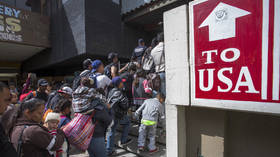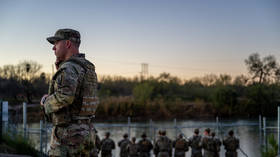Make no mistake, a new Civil War is a very real prospect for the US

Let’s sketch a big country in three broad strokes:
First, its population is over 333 million. These citizens privately own about (or at least) 339 million guns. They are unique in that no other state in the world has more private guns than people. They easily outdistance, for instance, Yemen, a country with a martial culture that has gone through years of civil war and yet there are only about 53 firearms per 100 inhabitants.
Second, polarization is unusually high and virulent: As of 2020 already, a political scientist at one of America’s most prestigious universities, found that “political polarization among Americans has grown rapidly in the last 40 years — more than in Canada, the United Kingdom, Australia or Germany,” for instance. The result: America is special, but not in a good way. “None of the wealthy, consolidated democracies of East Asia, Oceania, or Western Europe,” a 2022 paper published by the Carnegie Endowment for International Peace pointed out, “have faced similar levels of polarization for such an extended period.”
Last year, another Carnegie Endowment paper found that even while some of the perception of polarization on specific policy questions (such as gun control or abortion) is exaggerated, that perception itself is detrimental to the country’s cohesion. Because “the people who are most involved in civic and political life hold the least accurate [here meaning: highly negative] views of the other side’s beliefs” and there is a high degree of what political scientists call “affective polarization.” Put simply, all or many of those citizens, collectively hoarding so many guns that over 40% of households are armed in one way or the other, do not like or even merely respect “the other side” of the political spectrum – not at all and ever less.
Third, the country also displays a pronounced cultural preoccupation, really almost obsession, not merely with the idea of civil war as such or the specific history of its own very bloody civil war in the nineteenth century. Rather its elites and general population are fixated on a coming civil war, which, as of 2022, a whopping 43 percent considered likely in the next ten years. Debates, high-brow books, articles, and popular culture feature this fantasy prominently and persistently.
We are talking, of course, about the United States of America. While it would be easy to adduce more criteria and data points, there is no need. The above is sufficient to demonstrate that it would be shortsighted to pooh-pooh the risk of a second civil war in America, for two reasons: It is not a mere fantasy, owing its current national resonance to “hype” and the titillation of imagining a liberatingly apocalyptic future of chaos and every man and woman for themselves (and, in the US, I guess, every other gender that wishes to participate).
Smart Americans realize this as well. Barbara F. Walter, for instance, is a prominent political scientist who has worked extensively with the CIA to develop a model of civil war predictors, for any country but the US, of course. She has now come to warn that the model begins to fit America itself disturbingly well. She may have her centrist biases – the usual exaggeration of “Russian influence” included – but her core points are valid: The US is turning into an anocracy, that is, in essence, a regime that only pretends to be a democracy. (In fact, that is what it has always been, I would contend.) And there is a substantial constituency of those who feel threatened by losing their former social status and preeminence. Those happen to be phenomena strongly correlated with a risk of civil war.
Let’s also not forget that America is proving its enormous capacity for global disruption every day, even without civil war at home. While some observers may – even gleefully – hope that Americans fighting each other would finally have to let go of the rest of us, that is a very dicey bet. With an elite narcissistically obsessed with global “primacy” and “indispensability,” about 800 bases worldwide, an arsenal of thousands of nuclear warheads, and a nasty habit of blaming others for its own failures, a new American civil war would not exclude aggression abroad. Moreover, declining as it is, the US is still a key part of the global economy, much more so than in 1860, when its first civil war already had serious repercussions for the rest of the world.
In sum, it may attract preppers with camo baseball hats, beards, and pump guns, but don’t let that fool you: American Civil War 2.0 is a serious issue. So, what about it? What can we reasonably guess about how likely it really is and what shape it might take if it happens?
To start with the latter question, perhaps the first thing to note is that big civil wars can start small and local. That is, by the way, the real significance of the recent, open tensions over migration and border control between the state of Texas and the federal government in Washington. They did involve armed forces and much foreboding rhetoric, but, fortunately, no shots were fired. Yet those glibly dismissing the incident as mere political theater are wrong. Because, as the New York Times has noted, it was not only Texas that defied the US government. Rather, “many Republican state leaders publicly expressed defiance in terms that echoed armed conflicts.”
Indeed, the second thing to note is that, due to America’s federal structure, a new civil war would most likely begin with secession. In the fracas between Washington and Texas, 25 Republican governors openly sided with rebellious Texas. This was a perfect illustration of how one local flashpoint could quickly suck in the rest of the country by creating a logic of ultimate polarization and then secession. This logic has not yet fully unfolded. Its contours, however, have emerged clearly.
It is worth noting that many of the fiction narratives about Civil War 2.0 make the same point: Whether it is the cult graphic novel series “DMZ,” the bitterly ironic novel “American War” (it’s obvious in-joke is that it has some Americans treat other Americans the way Americans and Israelis now treat Palestinians, Iraqis, or Syrians), the small-budget yet clever movie “Bushwick,” or the big-budget “Civil War” about to hit American cinemas now: Again and again the basic premise is a scenario of secession escalating into massive domestic warfare.
Third, while the humongous pile of private firearms would certainly play a large role in a new civil war, it would be misguided to assume that such a fight would only pit gangs of private citizens, organized in militias, against official police and military forces. In reality, a dynamic of secession, once set in motion would lead to parts of the US’s manifold “siloviki” choosing their own allegiance, splitting, and starting to fight each other. If you believe that, in such a situation, the formal chains of command ultimately linking them all back to Washington would remain intact, I have a whole-and-indivisible Yugoslavia to sell you.
And, last but not least, in such a development, the war would be both severe and long. In that respect, it would resemble the first Civil War. Although, due to advanced technologies and declining inhibitions, it could be even more devastating and cruel. In Netflix’s recent and tellingly successful “Leave the World Behind,” the protagonists never learn who exactly is blowing up their country, but by the end of the movie two things seem reasonably clear: No, it’s not enemies from outside, but an inside job, and nukes are being used. That, by the way, was the premise as well of the earlier, initially unsuccessful but now cult television show “Jericho.”
How likely is such a dark future? Obviously, we do not know. But let’s note two things: We could, a priori, be looking at an America where no one is much interested in thinking about it. Yet we are seeing the opposite. If you think that means nothing, fine. Just don’t mistake your guess for a good policy or planning basis.
There are, of course, alternatives to civil war. One is peaceful de-polarization under the current anocratic conditions, which, hypothetically, can happen. The other is full-blown authoritarianism: one way to suppress the possibility of a civil war is to impose dictatorship.
But here’s the catch: A country can end up with both civil war and dictatorship. Ask the ancient Romans. Those Romans, that is, who were so much on the mind of the founders of the American Republic.
The statements, views and opinions expressed in this column are solely those of the author and do not necessarily represent those of RT.
















